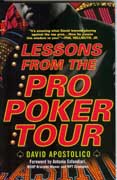
Lessons from the Pro Poker Tour
The Power of Aggression
You can’t underestimate the power of aggressive play late in a tournament. Here is the situation from a recent tournament I played. We were down to three players and we were already in the money. David Apostolico is the author of 'Machiavellian Poker Strategy', and 'Tournament Poker and The Art of War,' and his latest title 'Poker Strategies for a Winning Edge in Business.' David's website is www.holdemradio.com/blog/ Of course, second place is significantly more than third and first is significantly more than second. We still have plenty of chips to work with in relation to the blinds. That means we can still play post-flop poker.
David Apostolico is the author of 'Machiavellian Poker Strategy', and 'Tournament Poker and The Art of War,' and his latest title 'Poker Strategies for a Winning Edge in Business.' David's website is www.holdemradio.com/blog/ Of course, second place is significantly more than third and first is significantly more than second. We still have plenty of chips to work with in relation to the blinds. That means we can still play post-flop poker.
With three players left, I am the chip leader with about $35,000 in chips. Player A has about $25,000 and Player B has about $15,000. The blinds are $500-$1000 with $100 antes. Player A really turns on the heat and starts betting at most every pot. I’m picking up the pots he doesn’t take and Player B is slowly bleeding away. I’m waiting for the right opportunity to trap Player A but the cards are not cooperating. Since Player B seems intent on blinding out in the hopes that Player A and I will tangle in a big pot and allow Player B to slide into second place money. So unless I can trap Player A, I don’t want to get involved in a big pot with him.
By the end of this round, Player A has managed to wrestle the chip lead away from me and Player B is down to about $5000 in chips. The blinds jump to $1000-$2000 with $200 antes when I get KdJd in the big blind. Player A surprisingly folds on the button. Player B limps in the small blind and re-raise to put Player B all-in. He reluctantly calls with A-6 offsuit. A King comes on the flop and Player B hits the rail.
Now, we get the situation I was hoping for. I’m ready to attack Player A although after a couple of hands of back and forth, he’s able to build his stack at my expense. He’s up to about $45,000 in chips and I have $30,000 when the hand I have been waiting for finally comes. I get dealt AsKs on the button and make a mini-raise to $4000. Player A calls and we see a flop. The flop comes K-Q-2 and Player A fires out an $8000 bet. I’m tempted to raise but instead just smooth call hoping that Player A fires another bullet on the turn.
The turn brings an off suit 8 and Player doesn’t bite. Instead he checks. I immediately go all-in and hope he puts me on a steal or that he has a hand like K-10 and makes a crying call. He calls with little hesitation which gives me cause concern. When I flip over my hand, though, his face says it all. I don’t have to look at his cards to know I have him beat. He turns over Q-6 for second pair. I’m already counting first place money when a 6 rolls off the dealer’s hand on the river. Oh, well, that’s poker.
Player A realizes he made a bad call and apologizes for his lucky draw. I tell him not to. He played well and deserved to win. The truth is that he did play well by taking control of the table and grabbing the chip lead. Even though I executed according to my plan, my plan had flaws. I found a trapping but I still had to avoid a bad beat. What would have happened if that trapping hand didn’t come? I do believe I had started to fight back with aggression when we got head’s up. The mistake I made, though, was in relinquishing the chip lead in the first place. Once I did that I couldn’t afford to make any mistakes or weather any bad luck. Player A had that luxury once he took the chip lead.
I was confident I could out play Player A head’s up (and I think I did) but I never should have sacrificed the safety net of a superior chip stack.

